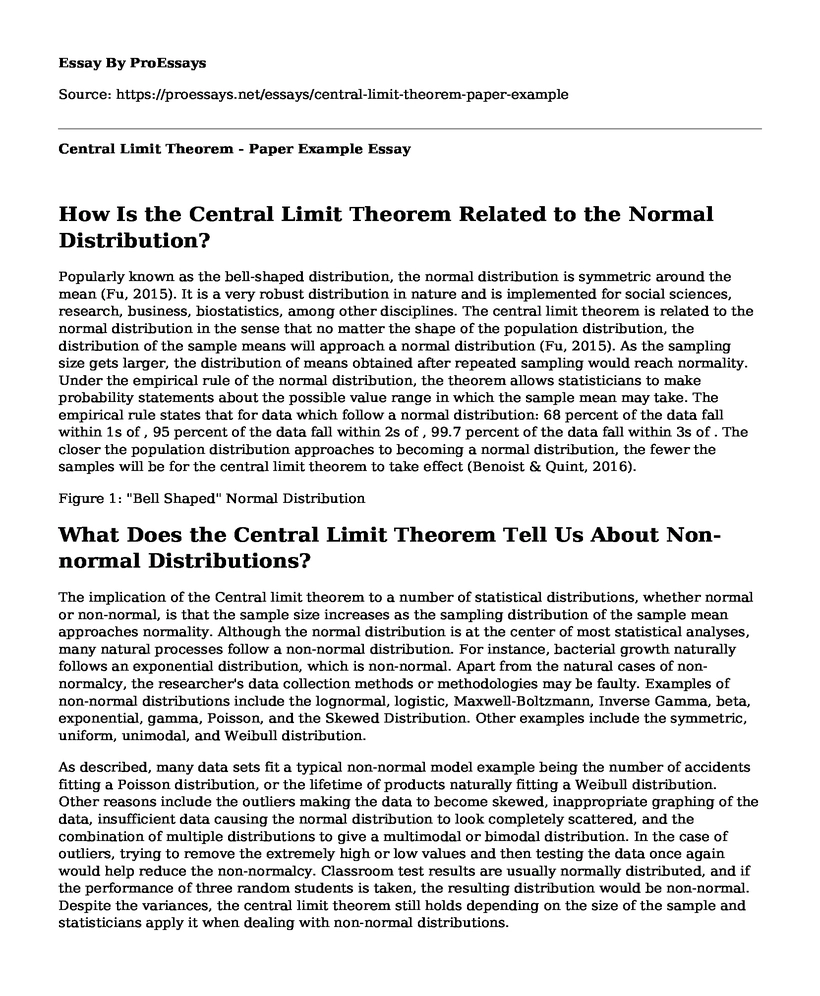How Is the Central Limit Theorem Related to the Normal Distribution?
Popularly known as the bell-shaped distribution, the normal distribution is symmetric around the mean (Fu, 2015). It is a very robust distribution in nature and is implemented for social sciences, research, business, biostatistics, among other disciplines. The central limit theorem is related to the normal distribution in the sense that no matter the shape of the population distribution, the distribution of the sample means will approach a normal distribution (Fu, 2015). As the sampling size gets larger, the distribution of means obtained after repeated sampling would reach normality. Under the empirical rule of the normal distribution, the theorem allows statisticians to make probability statements about the possible value range in which the sample mean may take. The empirical rule states that for data which follow a normal distribution: 68 percent of the data fall within 1s of , 95 percent of the data fall within 2s of , 99.7 percent of the data fall within 3s of . The closer the population distribution approaches to becoming a normal distribution, the fewer the samples will be for the central limit theorem to take effect (Benoist & Quint, 2016).
Figure 1: "Bell Shaped" Normal Distribution
What Does the Central Limit Theorem Tell Us About Non-normal Distributions?
The implication of the Central limit theorem to a number of statistical distributions, whether normal or non-normal, is that the sample size increases as the sampling distribution of the sample mean approaches normality. Although the normal distribution is at the center of most statistical analyses, many natural processes follow a non-normal distribution. For instance, bacterial growth naturally follows an exponential distribution, which is non-normal. Apart from the natural cases of non-normalcy, the researcher's data collection methods or methodologies may be faulty. Examples of non-normal distributions include the lognormal, logistic, Maxwell-Boltzmann, Inverse Gamma, beta, exponential, gamma, Poisson, and the Skewed Distribution. Other examples include the symmetric, uniform, unimodal, and Weibull distribution.
As described, many data sets fit a typical non-normal model example being the number of accidents fitting a Poisson distribution, or the lifetime of products naturally fitting a Weibull distribution. Other reasons include the outliers making the data to become skewed, inappropriate graphing of the data, insufficient data causing the normal distribution to look completely scattered, and the combination of multiple distributions to give a multimodal or bimodal distribution. In the case of outliers, trying to remove the extremely high or low values and then testing the data once again would help reduce the non-normalcy. Classroom test results are usually normally distributed, and if the performance of three random students is taken, the resulting distribution would be non-normal. Despite the variances, the central limit theorem still holds depending on the size of the sample and statisticians apply it when dealing with non-normal distributions.
Why Is the Central Limit Theorem Important to Discrete Event Simulations?
Since discrete event simulation models result in statistical estimates such as means and relative frequencies that are uncertain, a particular technique or techniques have to be used to quantify that inherent uncertainty. Many of the techniques are based on the central limit theorem. Discrete event simulation becomes handy if a researcher wants to understand processes and behaviors better as well as improve them to achieve business efficiency (Wainer & Mosterman, 2016). The simulations can accommodate variability and wide degrees of uncertainty. Statistical simulations have to be as precise as possible to achieve maximum accuracy. They involve the use of data and formulas to compute results. The central limit theorem is of fundamental use during results computation even in the most uncertain cases since it provides better and more accurate results.
Where in ARENA’s Category Overview Report Do We See the Influence of the Central Limit Theorem?
The influence of the Central Limit Theorem is observed in the summary statistics of Arena's Category Overview Report especially in relation to the averages, which helps to measure performance. Overall, the Central limit theorem is important in statistics as well as decision-making processes. Statistics and probability are essential intellectual tools in finance and business. Through statistics, a massive amount of information can be compressed to a few meaningful numbers, hence saving space and time. With probability, people can make rational decisions with the use of imperfect information by way of quantifying their uncertainty. Statistics has been termed as the bedrock of modernity since great human exploits such as putting rockets into orbits or managing spam filters all depend on probability and statistics.
Apart from mathematics, statistics could be applied to several other disciplines such as biology, genetics, chemistry, physics, and medicine. As stated earlier, the Central Limit Theorem has provided a good insight into the simulation with the ARENA tool. Using the Arena tool, statisticians could test real-life scenarios when it is difficult to do so in a natural setting. The simulation could also come in handy when the natural process of obtaining quantitative data necessary to perform the analysis is complicated. Essentially, the central limit theorem applied in simulation programs is important to many businesses.
References
Benoist, Y., & Quint, J. F. (2016). A central limit theorem for linear groups. The Annals of Probability, 44(2), 1308-1340.doi: 10.1214/15-AOP1002
Fu, M. C. (Ed.). (2015). Handbook of simulation optimization(Vol. 216). New York: Springer.
Wainer, G. A., & Mosterman, P. J. (2016). Discrete-event modeling and simulation: theory and applications. CRC press.
Cite this page
Central Limit Theorem - Paper Example. (2022, Nov 28). Retrieved from https://proessays.net/essays/central-limit-theorem-paper-example
If you are the original author of this essay and no longer wish to have it published on the ProEssays website, please click below to request its removal:
- Compare and Contrast Essay Example: the Moon and Mars
- Literature Review on Practical Use of Mathematics Essay
- Flat Earth vs. Round Earth - Argumentative Essay
- Paper Example on Mathematics Teaching
- Health Effect of Radiation Essay
- Galileo Theories and Experiments Essay
- Cause of Surface Tension Paper Example







